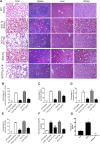Sphingosine-1-phosphate receptor 1 mediates elevated IL-6 signaling to promote chronic inflammation and multitissue damage in sickle cell disease
- PMID: 29401601
- PMCID: PMC5901384
- DOI: 10.1096/fj.201600788RR
Sphingosine-1-phosphate receptor 1 mediates elevated IL-6 signaling to promote chronic inflammation and multitissue damage in sickle cell disease
Abstract
Sphingosine-1-phosphate (S1P) is a biolipid involved in chronic inflammation in several inflammatory disorders. Recent studies revealed that elevated S1P contributes to sickling in sickle cell disease (SCD), a devastating hemolytic, genetic disorder associated with severe chronic inflammation and tissue damage. We evaluated the effect of elevated S1P in chronic inflammation and tissue damage in SCD and underlying mechanisms. First, we demonstrated that interfering with S1P receptor signaling by FTY720, a U.S. Food and Drug Administration-approved drug, significantly reduced systemic, local inflammation and tissue damage without antisickling effects. These findings led us to discover that S1P receptor activation leads to substantial elevated local and systemic IL-6 levels in SCD mice. Genetic deletion of IL-6 in SCD mice significantly reduced local and systemic inflammation, tissue damage, and kidney dysfunction. At the cellular level, we determined that elevated IL-6 is a key cytokine functioning downstream of elevated S1P, which contributes to increased S1P receptor 1 ( S1pr1) gene expression in the macrophages of several tissues in SCD mice. Mechanistically, we revealed that S1P-S1PR1 signaling reciprocally up-regulated IL-6 gene expression in primary mouse macrophages in a JAK2-dependent manner. Altogether, we revealed that elevated S1P, coupled with macrophage S1PR1 reciprocally inducing IL-6 expression, is a key signaling network functioning as a malicious, positive, feed-forward loop to sustain inflammation and promote tissue damage in SCD. Our findings immediately highlight novel therapeutic possibilities.-Zhao, S., Adebiyi, M. G., Zhang, Y., Couturier, J. P., Fan, X., Zhang, H., Kellems, R. E., Lewis, D. E., Xia, Y. Sphingosine-1-phosphate receptor 1 mediates elevated IL-6 signaling to promote chronic inflammation and multitissue damage in sickle cell disease.
Keywords: JAK2; S1PR1; macrophage.
Conflict of interest statement
This work was supported by U.S. National Institutes of Health, National Heart, Lung, and Blood Institute Grants HL113574, HL114457, HL136969, and HL137990 (to Y.X.). The authors declare no conflicts of interest.
Figures




References
-
- Lee O. H., Kim Y. M., Lee Y. M., Moon E. J., Lee D. J., Kim J. H., Kim K. W., Kwon Y. G. (1999) Sphingosine 1-phosphate induces angiogenesis: its angiogenic action and signaling mechanism in human umbilical vein endothelial cells. Biochem. Biophys. Res. Commun. 264, 743–750 10.1006/bbrc.1999.1586 - DOI - PubMed
-
- Liang J., Nagahashi M., Kim E. Y., Harikumar K. B., Yamada A., Huang W. C., Hait N. C., Allegood J. C., Price M. M., Avni D., Takabe K., Kordula T., Milstien S., Spiegel S. (2013) Sphingosine-1-phosphate links persistent STAT3 activation, chronic intestinal inflammation, and development of colitis-associated cancer. Cancer Cell 23, 107–120 10.1016/j.ccr.2012.11.013 - DOI - PMC - PubMed
Publication types
MeSH terms
Substances
Grants and funding
LinkOut - more resources
Full Text Sources
Other Literature Sources
Medical
Molecular Biology Databases
Miscellaneous

